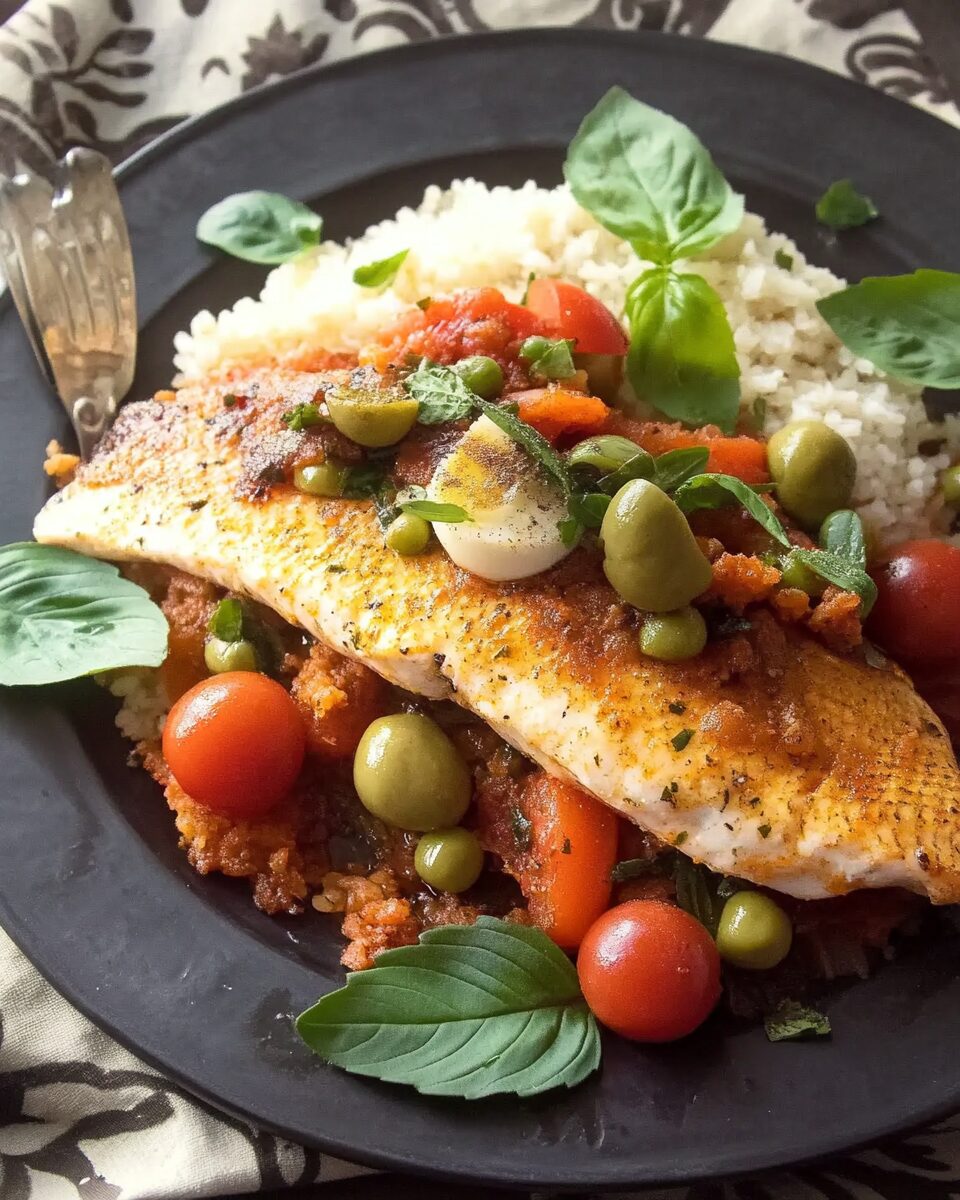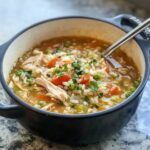Spanish Moroccan Fish is a cherished recipe that has been passed down through generations, blending the rich culinary traditions of both Spanish and Moroccan cuisines. This dish features white fish fillets simmered with a medley of vegetables, spices, and garbanzo beans, resulting in a flavorful and hearty meal. It’s versatile enough to be served hot or cold, making it suitable for various occasions.
Full Recipe:
Ingredients
- 2 tablespoons olive oil
- 1 onion, chopped
- 2 cloves garlic, minced
- 1 red bell pepper, chopped
- 2 carrots, sliced
- 4 tomatoes, chopped
- ½ cup sliced green olives
- 1 (15-ounce) can garbanzo beans, drained
- 1 teaspoon ground cumin
- 1 teaspoon paprika
- Salt and ground black pepper to taste
- 1 pound white fish fillets (such as tilapia or cod)
- ½ cup chopped fresh cilantro
Directions
-
Heat olive oil in a large skillet over medium heat. Sauté onion and garlic until softened, about 5 minutes.
-
Add red bell pepper and carrots; cook for another 5 minutes.
-
Stir in tomatoes, green olives, garbanzo beans, cumin, paprika, salt, and pepper. Simmer for 10 minutes.
-
Place fish fillets on top of the vegetable mixture. Cover and cook until the fish flakes easily with a fork, about 10 minutes.
-
Garnish with chopped cilantro before serving.
Nutritional Facts (per serving)
- Calories: 350
- Total Fat: 12g
- Saturated Fat: 2g
- Cholesterol: 55mg
- Sodium: 600mg
- Total Carbohydrates: 30g
- Dietary Fiber: 8g
- Total Sugars: 8g
- Protein: 28g
Cultural Significance and Origins
This dish finds its roots in two deeply rich culinary traditions. Moroccan cuisine is known for its use of warming spices, preserved ingredients like olives and lemons, and slow-simmered dishes that build depth over time. Spanish cuisine brings brightness and freshness, often through tomatoes, peppers, garlic, and olive oil. In regions like Andalusia and along the Mediterranean coast, culinary traditions overlap, especially when it comes to seafood.
The recipe likely evolved in multicultural households or coastal communities where fresh fish was abundant and spices were integral to everyday cooking. Jewish, Berber, and Arab cuisines also played a major role in influencing Moroccan cooking, with Spanish flavors integrating seamlessly through Moorish Spain and subsequent migrations.
Spanish Moroccan Fish pays homage to these intertwined histories and serves as a flavorful example of how culinary boundaries blend to create dishes that transcend borders.
The Role of Fish in Mediterranean and North African Diets
Fish plays a central role in the diets of both Moroccan and Spanish households, especially in coastal regions. Rich in lean protein, omega-3 fatty acids, and essential vitamins, fish is a healthy alternative to red meat. In this recipe, white fish is preferred for its light texture, subtle flavor, and ability to absorb spices and sauces.
The use of fish in this dish also speaks to sustainability. Many types of white fish like tilapia, cod, or hake are readily available, affordable, and cook quickly. The mild taste makes them ideal for bold spice blends without being overpowering.
This dish is a shining example of how healthy eating doesn’t have to be bland. Fish takes on the personality of the spices and ingredients it’s cooked with, creating a meal that’s both satisfying and nourishing.
Aromatic Vegetables and Herbs
Another pillar of this recipe’s appeal is its use of aromatic vegetables and herbs. Onion, garlic, bell peppers, and carrots form the base of the dish, creating a natural sweetness and depth as they cook down. Tomatoes provide acidity and moisture, helping to create a sauce that the fish gently simmers in.
Fresh cilantro added at the end brings brightness and contrast to the richness of the cooked vegetables and beans. This layering of fresh and cooked ingredients adds to the flavor complexity and texture of the final dish.
Green olives bring in a salty, tangy element that’s typical of Moroccan cuisine, where briny ingredients are used to balance sweetness and acidity. Combined, these vegetables and herbs form a rustic, colorful stew that’s as visually appealing as it is delicious.
The Importance of Spices
Spices are the heart of Moroccan cooking, and this recipe showcases them in a subtle yet impactful way. Cumin and paprika are the two primary spices, providing warmth and smokiness without overpowering the other flavors.
Cumin is earthy and grounding, a staple in Moroccan kitchens. Paprika, whether sweet or slightly smoky, adds depth and a hint of color. These spices are gentle enough to complement the delicate fish but flavorful enough to transform the dish into something memorable.
While not overly spicy, this dish still feels warming and comforting, making it suitable for a variety of palates. It’s a beautiful example of how a few well-chosen spices can elevate humble ingredients into something extraordinary.
The Role of Garbanzo Beans
Garbanzo beans, also known as chickpeas, are another hallmark of Moroccan and Spanish cooking. They are high in fiber, plant-based protein, and essential nutrients such as folate and iron. In this dish, they serve a dual purpose: adding bulk to make the dish more filling and offering a creamy contrast to the flaky fish.
They also absorb the flavors of the sauce and spices beautifully, making every bite rich and cohesive. Garbanzo beans add heartiness without heaviness, transforming this from a simple seafood dish into a well-rounded, balanced meal.
Cooking Technique and Texture
Spanish Moroccan Fish is traditionally simmered gently in a wide skillet, with the fish layered on top of the stewed vegetables and legumes. This technique allows the steam and heat from the sauce to cook the fish delicately, ensuring it remains moist and tender.
The vegetables soften into a flavorful base while the fish flakes effortlessly with a fork. The final texture is a delightful combination of tender fish, soft vegetables, and toothsome beans, all tied together by a fragrant tomato-based broth.
This gentle cooking process is forgiving, making it an ideal dish for both beginner cooks and seasoned chefs who want to focus on flavor rather than finesse.
Meal Versatility and Presentation
One of the greatest strengths of Spanish Moroccan Fish is its versatility. It can be served over couscous, rice, or crusty bread to soak up the sauce. It works equally well with a side of roasted vegetables or a fresh salad. The dish can also be portioned and chilled for later, as the flavors deepen and improve over time.
It’s perfect for entertaining, as it looks vibrant on the plate and is easy to prepare in larger batches. The stew-like presentation gives it a rustic charm, while the colorful ingredients and herbs make it look restaurant-worthy.
Because it’s satisfying without being heavy, this dish suits a range of settings—from casual family dinners to more formal gatherings.
Nutritional Benefits
Spanish Moroccan Fish is as healthy as it is delicious. The dish is packed with:
-
Lean protein from white fish, which supports muscle growth and repair
-
Healthy fats from olive oil and olives
-
Fiber and plant-based protein from garbanzo beans
-
Vitamins and antioxidants from tomatoes, peppers, garlic, and herbs
-
Low saturated fat and moderate calories, making it suitable for heart-healthy diets
It is naturally gluten-free and dairy-free, making it accessible to many dietary needs. It’s also adaptable for those following a Mediterranean diet, low-carb lifestyle, or those simply trying to eat more whole foods.
Sustainability and Local Adaptation
The dish can be made with a variety of locally available fish, making it sustainable and flexible. Home cooks can use whatever mild white fish is freshest or most affordable, supporting local fisheries or markets.
This flexibility ensures that the dish can be enjoyed worldwide, regardless of location or access to specific ingredients. Its core flavors remain intact, allowing it to honor its origins while embracing modern adaptations.
Tips for Making It Your Own
While the traditional preparation is deeply flavorful, there are many ways to personalize this recipe:
-
Add heat with a touch of cayenne or chopped chili
-
Stir in preserved lemon for extra brightness
-
Swap garbanzo beans for white beans or lentils
-
Use parsley instead of cilantro, if preferred
-
Top with toasted almonds or pine nuts for crunch
-
Add a squeeze of lemon or lime before serving to enhance freshness
These small changes allow home cooks to tailor the dish to their tastes without losing its identity.
Family-Friendly Appeal
Thanks to its mild spice level and soft textures, this recipe is great for families, including kids or those with more sensitive palates. The familiar ingredients—tomatoes, carrots, beans, and mild fish—are comforting and accessible, while the gentle spices introduce young or hesitant eaters to new flavors without overwhelming them.
It’s also an excellent way to include more seafood and legumes in the diet, two food groups often underrepresented in daily meals.
Storage and Reheating
Spanish Moroccan Fish stores well in the refrigerator for up to three days. As with many stews and braised dishes, the flavor intensifies as it sits. To reheat, simply warm gently on the stovetop or in the microwave until heated through, adding a splash of water or broth if needed to loosen the sauce. It can also be frozen in portions for future meals, making it a great candidate for meal prep or batch cooking.
Conclusion
Spanish Moroccan Fish is a celebration of cultural fusion, flavor harmony, and nutritional balance. With its fragrant spices, tender fish, and hearty legumes, it offers an experience that’s both comforting and exciting. The recipe demonstrates how everyday ingredients, when treated with care and paired thoughtfully, can create a dish that feels special.






